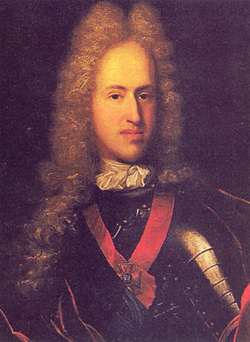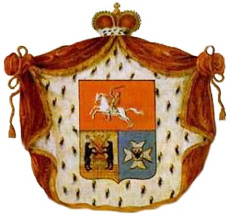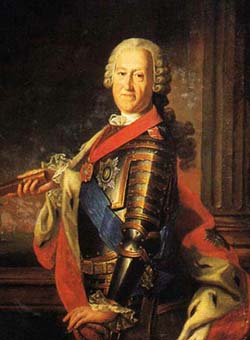|
 Prince Mikhail Mikhailovitch Golitsin (1675-1730), Field Marshal General, was a talented Russian
commander of the era of Peter the Great, and a participant in the Northern war (1700-1721). Golitsin commenced his military career as a private
soldier (drummer) of the Semenovsky Regiment. In 1694 he was promoted to second lieutenant (praporschik). Golitsin excelled in the Azov
campaigns (1695–1696) of Peter I against the Ottoman Empire. He continued his military career with great success. In November 1702 he took
part in the taking of the Noteburg Fortress. After a thirty-hour assault, Noteburg (Oreshek) fell to the Russians. Peter renamed the fort
Schlusselburg (Key Castle), a name of significance to the Swedes.
After the battle for the Noteburg Fortress, the Russian forces gradually
moved down the Neva River to the Swedish fortress of Niensants. Niesants fell after an eight-day siege by the Russians on May 1, 1703.
Golitsin was actively involved at all times during these battles. Later on he took part in taking the fortresses of Narva (1704) and Mitau (1705).
In August 1708, he led the Russian attack at Malatitze (Dobroe), and he commanded the Guards at the Battle of Poltava.
Prince Mikhail Mikhailovitch Golitsin (1675-1730), Field Marshal General, was a talented Russian
commander of the era of Peter the Great, and a participant in the Northern war (1700-1721). Golitsin commenced his military career as a private
soldier (drummer) of the Semenovsky Regiment. In 1694 he was promoted to second lieutenant (praporschik). Golitsin excelled in the Azov
campaigns (1695–1696) of Peter I against the Ottoman Empire. He continued his military career with great success. In November 1702 he took
part in the taking of the Noteburg Fortress. After a thirty-hour assault, Noteburg (Oreshek) fell to the Russians. Peter renamed the fort
Schlusselburg (Key Castle), a name of significance to the Swedes.
After the battle for the Noteburg Fortress, the Russian forces gradually
moved down the Neva River to the Swedish fortress of Niensants. Niesants fell after an eight-day siege by the Russians on May 1, 1703.
Golitsin was actively involved at all times during these battles. Later on he took part in taking the fortresses of Narva (1704) and Mitau (1705).
In August 1708, he led the Russian attack at Malatitze (Dobroe), and he commanded the Guards at the Battle of Poltava.
 During the second
stage of the battle the strongest segment of the Russian infantry consisted of two most battle worthy regiments - Semenovski and Preobrazhenski.
Under the overall command of Golitsin, these regiments were instrumental in breaking the Swedish front line, thus making victory possible for the
Russian forces. In 1711 Mikhail Golitsin took part in the unsuccessful Prut campaign against the Turks. In 1714 he was sent to Finland where he
led the Russian army in their defeat of the Fins in the battle of Pälkäne and battle of Storkyro (Isokyrö). About 5,000 Finns were killed and some
10,000 taken away as slaves. Only a few thousand were able to later return to their homeland. After the victory at Isokyrö, Mikhail Golitsin became
governor of Finland. The Finnish peasants were forced to pay large contributions to the occupying Russians.
During the second
stage of the battle the strongest segment of the Russian infantry consisted of two most battle worthy regiments - Semenovski and Preobrazhenski.
Under the overall command of Golitsin, these regiments were instrumental in breaking the Swedish front line, thus making victory possible for the
Russian forces. In 1711 Mikhail Golitsin took part in the unsuccessful Prut campaign against the Turks. In 1714 he was sent to Finland where he
led the Russian army in their defeat of the Fins in the battle of Pälkäne and battle of Storkyro (Isokyrö). About 5,000 Finns were killed and some
10,000 taken away as slaves. Only a few thousand were able to later return to their homeland. After the victory at Isokyrö, Mikhail Golitsin became
governor of Finland. The Finnish peasants were forced to pay large contributions to the occupying Russians.
 Plundering was widespread, especially
in Ostrobothnia and in communities near the major roads, and many churches were looted. Isokyrö itself was burned to the ground. A scorched earth
zone of several hundred kilometers was created to deter any Swedish counteroffensives. In 1714 he led the battle at Gangut in the Baltics. At the
end of July 1720, Golitsin’s galley fleet crushed the Swedish fleet in the battle of Grengam. From 1721 to 1723 he commanded troops in
St. Petersburg, and from 1723 to 1728 he was in charge of the Russian troops in Ukraine. In 1728 Golitsin was appointed president of the Military
Collegium, the headquarters of the Russian army and arm of the central government. He also was appointed senator and member of the Supreme
Privy Council. In 1730 Mikhail Golitsin resigned and soon thereafter died. His son Alexander (1718-1783) was a diplomat and soldier, who likewise
rose to be field marshal and governor of St Petersburg. Another son, Dmitriy (1721-1793), was the Russian ambassador to Vienna during the reign
of Catherine the Great. Although he is primarily remembered for the splendid Golitsin Hospital he opened in Moscow, he should also be recognized
as a great friend and patron of Mozart.
Plundering was widespread, especially
in Ostrobothnia and in communities near the major roads, and many churches were looted. Isokyrö itself was burned to the ground. A scorched earth
zone of several hundred kilometers was created to deter any Swedish counteroffensives. In 1714 he led the battle at Gangut in the Baltics. At the
end of July 1720, Golitsin’s galley fleet crushed the Swedish fleet in the battle of Grengam. From 1721 to 1723 he commanded troops in
St. Petersburg, and from 1723 to 1728 he was in charge of the Russian troops in Ukraine. In 1728 Golitsin was appointed president of the Military
Collegium, the headquarters of the Russian army and arm of the central government. He also was appointed senator and member of the Supreme
Privy Council. In 1730 Mikhail Golitsin resigned and soon thereafter died. His son Alexander (1718-1783) was a diplomat and soldier, who likewise
rose to be field marshal and governor of St Petersburg. Another son, Dmitriy (1721-1793), was the Russian ambassador to Vienna during the reign
of Catherine the Great. Although he is primarily remembered for the splendid Golitsin Hospital he opened in Moscow, he should also be recognized
as a great friend and patron of Mozart.
|
 History
History
 Dates and events
Dates and events
 Persons
Persons
 Poltava
Poltava
 Sights
Sights
 Photo gallery
Photo gallery
 Maps
Maps
 Virtual Museum
Virtual Museum
 Armament
Armament
 Uniforms
Uniforms
 Coins and medals
Coins and medals
 Flags
Flags
 Paintings
Paintings
 Poltava photographs
Poltava photographs
 News
News
 About us
About us
 Acknowledgments
Acknowledgments
 Main page
Main page
 top
top ...back
...back  History
History
 Dates and events
Dates and events
 Persons
Persons
 Poltava
Poltava
 Sights
Sights
 Photo gallery
Photo gallery
 Maps
Maps
 Virtual Museum
Virtual Museum
 Armament
Armament
 Uniforms
Uniforms
 Coins and medals
Coins and medals
 Flags
Flags
 Paintings
Paintings
 Poltava photographs
Poltava photographs
 News
News
 About us
About us
 Acknowledgments
Acknowledgments
 Main page
Main page